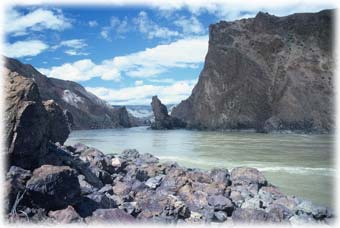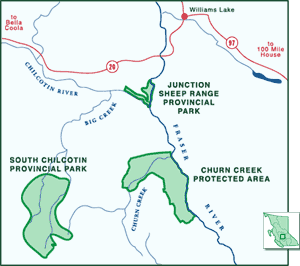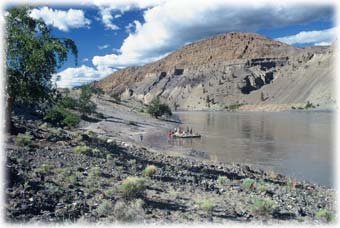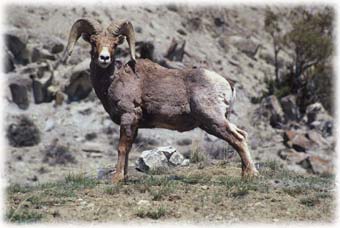|
|
|
|
|
|
|
 The Churn Creek Protected Area is one of a limited number of areas in British Columbia that have been set aside specifically for the preservation of rare bunchgrass grassland ecosystems. In a province so well endowed with dramatic mountains and forests the more subdued grassland landscapes have been frequently overlooked. This lack of attention, along with the ease with which grasslands can be converted to agricultural lands, has resulted in these fragile areas becoming BC's rarest and most endangered ecosystem. About 1% of BC's grasslands has received protection; in contrast 6% of old growth rainforests are preserved. Thus, protected areas like Churn Creek have been established in recent years in order to allow important grassland communities to survive and flourish. The Churn Creek Protected Area is one of a limited number of areas in British Columbia that have been set aside specifically for the preservation of rare bunchgrass grassland ecosystems. In a province so well endowed with dramatic mountains and forests the more subdued grassland landscapes have been frequently overlooked. This lack of attention, along with the ease with which grasslands can be converted to agricultural lands, has resulted in these fragile areas becoming BC's rarest and most endangered ecosystem. About 1% of BC's grasslands has received protection; in contrast 6% of old growth rainforests are preserved. Thus, protected areas like Churn Creek have been established in recent years in order to allow important grassland communities to survive and flourish.
This means that while Churn Creek Park offers a range of recreational opportunities, the priority is protection, and visitors should keep that in mind. There are specific regulations in the area to ensure Churn Creek is managed in a way that assures the survival of the delicate and beautiful grasslands. Still, the 36,100 hectare (89,207 acre) Churn Creek Protected Area offers hikers, horseback riders, or those just passing through the chance to experience and enjoy the subtle beauty of this hot, dry, and rare ecosystem. The park also contains both the Churn Creek and main Fraser River Canyon, two unique and spectacular features.
|
|
"In a province so well endowed with dramatic mountains and forests the more subdued grassland landscapes have been frequently overlooked."
|

The drive to Churn Creek Protected Area includes several hours on unpaved roads that can become dangerous when wet, as they turn into slick, greasy mud. Visitors should be aware of this and try to avoid the drive when the roads are excessively wet. The area is remote and somewhat difficult to reach. There are two possible access routes.
The simplest access is from Williams Lake. Take Highway 97 south, turning onto to the Enterprise Road (with caution-tit is an active logging road). Continue to the Dog Creek turnoff, and follow the signs to Gang Ranch. After crossing the Fraser River Bridge turn left at the next intersection onto the Empire Valley Road, which continues into the Protected Area.
Alternatively Churn Creek Park can be reached from Clinton, by driving north on Highway 97 and then following the signs to Big Bar Lake Park. After Big Bar Lake Park turn right at the next T-intersection, continue through Canoe Creek village and across the Fraser River Bridge. From there follow the same directions as the above route.

Click on the map to view an enlargement
|
|
"Churn Creek is an especially important area to protect because in addition to supporting the bunchgrass ecosystem, it also is home to a variety of other habitats including shrub-steppes, wetlands, kettle lakes, and dry open forests."
|

 There are a variety of ways to explore the beautiful and unique Churn Creek Protected Area, including hiking, biking and horseback riding, and rafting down the Fraser River. Hikers, bikers, and groups of more than 12 horses are required to stay on trails and roads. This requirement protects the fragile lichen crust that forms between bunchgrass clumps. Most of the trails are old cattle trails, which are no longer used for that purpose. Small groups of horses (less than 12) may venture into the grasslands, but must do so with respect and care for the delicate environment. There are a variety of ways to explore the beautiful and unique Churn Creek Protected Area, including hiking, biking and horseback riding, and rafting down the Fraser River. Hikers, bikers, and groups of more than 12 horses are required to stay on trails and roads. This requirement protects the fragile lichen crust that forms between bunchgrass clumps. Most of the trails are old cattle trails, which are no longer used for that purpose. Small groups of horses (less than 12) may venture into the grasslands, but must do so with respect and care for the delicate environment.
A code of ethics for horseback riding in Churn Creek has been developed and should be read and followed by all visitors planning to bring horses. This code of ethics also provides information on how horses should be fed in the protected area (as grazing is prohibited) and how groups of 12 or more horseback riders register as is required for large groups.
Please visit BC Parks Churn Creek Protected Area site for more information.
While backcountry camping is permitted, there are no developed camping sites in Churn Creek Protected Area. The area around the Empire Valley Ranch Calving Barn is a suggested place to camp though, especially for groups with horses. It has a pit toilet and corrals, as well as a nearby creek with water. In most of the rest of this dry protected area water is a scare resource and visitors are cautioned to carry water in rather than assuming it will be available. Firewood is also unavailable in the park, and visitors wishing to have campfires must carry in their own.
"There are a variety of ways to explore the beautiful and unique Churn Creek Protected Area, including hiking, biking and horseback riding, and rafting down the Fraser River."
The very scenic Churn Creek Canyon is an excellent destination for day hikers, as are the lovely sandy beaches along the shores of the Fraser River. These beaches are fabulous places to relax and enjoy the area, and are also wonderful for camping.
Special notes for the protection of grasslands
- There are special limitations applied to large horse groups in the park. Please click here to learn more. There is also an adapted code of ethics for all horseback riders who visit Churn Creek. If you are planning to bring horses to this Protected Area please read the code of ethics.
- ·ATVs and motorbikes are prohibited everywhere in the park, and cars and other vehicles must remain on established roads.
- There are special measures in place to reduce the likelihood of invasive weed species moving into the park. Please visit the BC Parks website to learn about these measures.
|

 Churn Creek Protected Area was created specifically to protect its dominant groundcover: the rare bunchgrass ecosystem. The area represents one of the most northerly examples of this ecosystem in North America, and is the best protected example in BC. Bunchgrass ecosystems are characterised by clumps of perennial grasses separated by an unusual soil-like complex of lichens, fungi, and other organisms known as cryptogamic soil. Spiky prickly pear cacti are also common within the ecosystem. For more information on grassland plants and cryptogamic soil ecology visit BC Parks' Grassland Plants Ecology page. Churn Creek Protected Area was created specifically to protect its dominant groundcover: the rare bunchgrass ecosystem. The area represents one of the most northerly examples of this ecosystem in North America, and is the best protected example in BC. Bunchgrass ecosystems are characterised by clumps of perennial grasses separated by an unusual soil-like complex of lichens, fungi, and other organisms known as cryptogamic soil. Spiky prickly pear cacti are also common within the ecosystem. For more information on grassland plants and cryptogamic soil ecology visit BC Parks' Grassland Plants Ecology page.
Churn Creek is an especially important area to protect because in addition to supporting the bunchgrass ecosystem, it also is home to a variety of other habitats including shrub-steppes, wetlands, kettle lakes, and dry open forests. The area also features a significant gradient of ecosystems from the higher Spruce-Pine forest, to interior Douglas Fir through to the grasslands of the Lower Fraser Canyon. This diversity of plant types means that this Protected Area supports an abundance of animals.
Many of these species, because they have such restricted habitats, are threatened or endangered. Birds such as the peregrine falcon and the flammulated owl among others, as well as several species of snakes are some of the threatened animals found in Churn Creek. The Protected Area also features some of the best habitat in BC, especially in winter, for California Bighorn sheep and mule deer.
The Churn Creek Valleys are also the connecting migration corridor used by sheep and deer to reach their summer range in the Spruce Lake and Big Creek areas of the South Chilcotin Mountains. The Churn Creek area is also home to cougars, black bears, lynx, bobcats, and many other small mammals. The area's wetlands, lakes, and streams are home to another distinct set of species including waterfowl, reptiles and amphibians.
"Churn Creek is an especially important area to protect because in addition to supporting the bunchgrass ecosystem, it also is home to a variety of other habitats including shrub-steppes, wetlands, kettle lakes, and dry open forests."
|

The earliest peoples to make their home in the Churn Creek Area were the Ts'ilhqot'in (Chilcotin) and Secwepemc (Shuswap) First Nations peoples. There is evidence in the area of use for as long as 7000 years. By the 1860s the first Europeans had reached the area, and the local Natives began to be involved in the fur trade. When gold was discovered in the Cariboo more and more non-Natives made their home in the area. Ranching soon became the region's main economic base, and by the early 1900s the Empire Valley was a popular ranching area. Ranching, along with some mining and forestry, continued to be the most important industry in the area until its protection in 1995.
Churn Creek was identified by Parks Canada in their assessment of high priority conservation opportunities because it features the highest calibre winter wildlife range in the Central Interior, especially for California Bighorn sheep and deer. The National Park plan was never carried through though, because it faced opposition from local ranchers who feared they would lose the opportunity to graze their cattle in the area.
When the BC Government's Cariboo-Chilcotin CORE (Commission on Resources and the Environment) table concluded in the mid-90s the Churn Creek area was recommended for protection. Conservationists active in the process were successful in protecting the present day Churn Creek area, as well as the nearby headwaters in the south Chilcotin Mountains. In addition, a written agreement was drafted to ensure the wildlife migration corridor between the two protected areas would be retained.
"Churn Creek was identified by Parks Canada in their assessment of high priority conservation opportunities because it features the highest calibre winter wildlife range in the Central Interior, especially for California Bighorn Sheep and deer."
Return to the Chilcotin Region
Become Involved!

|
|

